Menu

Did you know California’s farms have over 3,000 back injuries a year? These cost more than $22 million in workers’ compensation. This shows why ergonomic training for farm hands is vital. It helps cut down on back injuries and other health problems from hard work.
The NC AgrAbility initiative is leading the charge. It helps farm hands who suffer from repeating the same motions and lifting heavy objects. The program teaches them the right ways to move and even gives out special tools. These efforts are key to keeping farm workers healthy. Also, a tech library helps them reduce the chance of getting hurt.
With funding from grants, NC AgrAbility does a lot. It not only gets the right tools for its worker but also creates teaching materials. This all-around approach aims to fix the lack of workers in farming and to make sure the industry’s workers are safe and healthy.
Farm work is physically demanding, leading to health risks like back pain and sprains. These risks come from forceful actions and the use of vibrating tools. Therefore, training in ergonomics is vital to keep farm workers safe and healthy.
Back pain, and shoulder and hand aches are common among farm workers. Shockingly, many workers get hurt because of sprains, strains, and back problems. In California, dealing with these injuries costs more than $22 million each year. This shows why farm safety training and ergonomics are so important.
The National Institute for Occupational Safety and Health (NIOSH) highlights that adopting better work practices and ergonomic tools significantly reduces sprains and strains in farm work.
Ergonomics ensures workers are safe, comfortable, and productive by fitting the job to the worker. By making small changes – like better work postures and less stress on the body – we can cut down on injuries. These simple ergonomic tweaks are key to making farm work safer.
| Statistic | Detail |
|---|---|
| Backaches and pain reports | Most common symptoms among farm workers |
| Sprains and strains | 1/3 of injuries that cause missed work |
| Back injuries | 1/4 of injuries |
| Compensation costs in California | Over $22 million annually |
Mixing ergonomics with good safety training can make farm work safer. For example, arranging tools and items closer to workers can cut down on injuries. So, focusing on ergonomics in training and at the workplace helps farm workers a lot.
Musculoskeletal disorders cause pain in the back, shoulders, arms, and hands for farm workers. This is due to doing the same movements over and over, heavy lifting, and bending oddly. Osborne et al.’s 2012 research showed that 55.2% of farmers have these health problems.
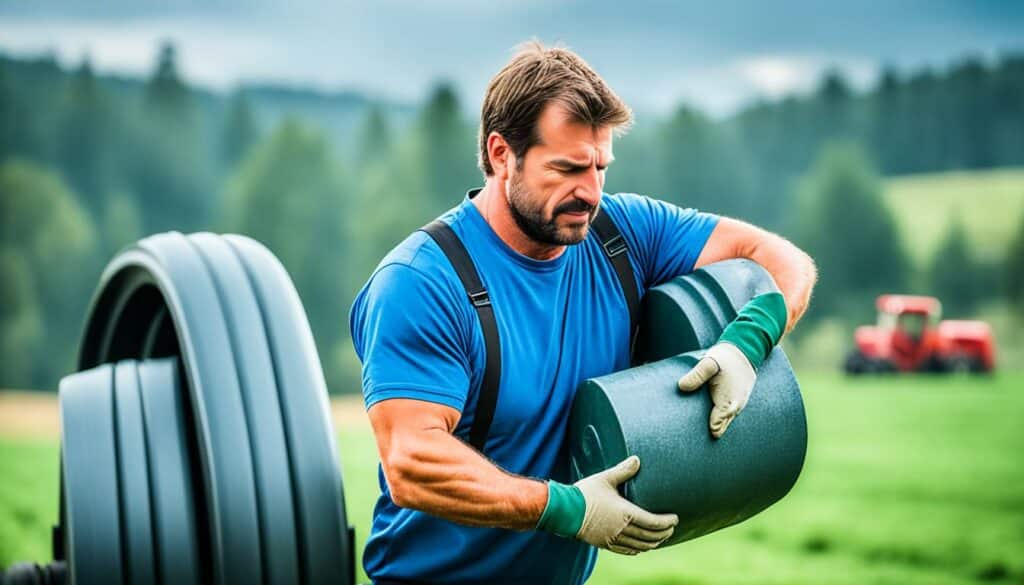
Jain et al. found that in 2018, 68.7% of farmers in Rajasthan faced these issues. Momeni et al.’s 2020 study in Iran also found 25.6% of farm workers had musculoskeletal symptoms.
To fight these problems, teaching is crucial for farm labourers. Shorthouse et al.’s work in 2016 reduced low back pain by 15% with education. Also, Plantation A’s method in 2014 cut symptoms by 22% among oil palm workers. And Ya’acob et al. in 2018 saw a 30% decrease using special training.
Heavy lifting and bad postures are big causes of these pains. Mokarami et al.’s suggestions in 2019 cut risk factors for dairy farm workers by 27%. Similarly, Pranav et al. in 2016 saw an 18% decrease for orange harvesters with better training.
Since the 1988 National Health Interview Survey, we’ve known that agriculture workers often suffer back pain. They were 1.5 times more likely to report it than people in other industries. This makes it clear: We need to teach farm workers about ergonomics and using tools to stay safe.
With so many farm workers getting musculoskeletal disorders, we must offer specific training. This can lower health dangers and help both the workers and their bosses.
An effective ergonomic training course is vital for farm workers. It teaches them about good body movements and postures. It also includes learning how to use gadgets that assist. These bits together form a helpful field worker safety program. The goal is to lower the chance of muscle and bone problems, common in farm work.
Central to every agricultural ergonomics course is the essence of correct body moves and steady posture. Many farm workers complain of back pain or pain in the arms and hands. Such pains come from wrong ways of lifting, stretching too far, or standing oddly. So, training should teach methods to cut these risks, like:
Addressing these issues helps workers avoid injuries on the job.
Showing how specific tools can make the work easier is key in the field worker safety program. Some helpful tools are:
Using these tech and tips in the agricultural ergonomics course helps make work smoother and safer. It all adds up to keeping farm workers healthy and happy.
The high number of musculoskeletal disorders (WMSDs) in farming shows the need for specific ergonomic interventions to tackle them. Farm hands often suffer from backaches, shoulder pain, and strains.
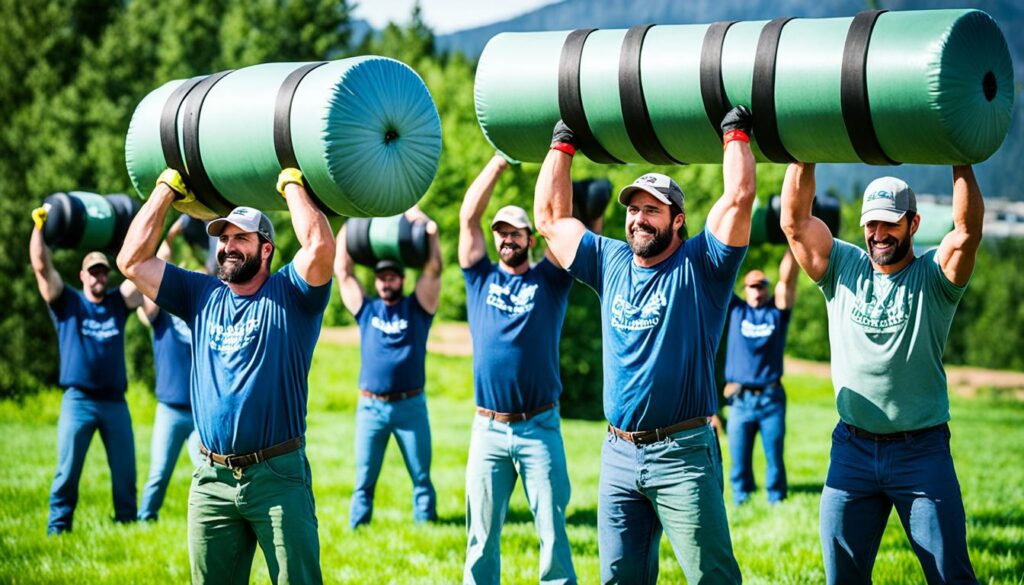
In California, yearly costs for workers’ back injuries top $22 million. This makes it clear why we need to focus on ergonomics. By changing tool designs and work methods, we want to make sure the job fits the worker well.
Ergonomic rules suggest some simple but effective ideas:
It’s key to limit how heavy things are that need lifting to under 50 lbs or figure out safe weights using tools like the NIOSH Lifting Equation. This helps prevent injuries and leads to better body positions when working. Also, by making tools easier to hold or adding grips that don’t slip, we can lessen hand injuries.
Agriculture ergonomics courses and actions are making big changes on farms. They could include providing seats for lower-down jobs, using mats for those who stand a lot, and mixing up the tasks to ease the workload. Having the farm workers involved in finding solutions can bring about new, task-specific ideas.
The overall goal of agricultural ergonomics courses is to make working in farming safer and more pleasant. This boosts how much work gets done and how happy the workers are.
Farm work is tough and often causes health problems. This is mainly because of heavy lifting and manual tasks. These activities can hurt the body over time. Assistive technology is key to helping these farm workers stay healthy.
The United States has a lack of farm workers, as Gutierrez-Li (2021) points out. Places like North Carolina often seek more workers. This is due to tasks that are physically demanding and the lack of training on how to lift properly. As a result, many farmworkers get hurt.
To make things better, people are mixing training in how to work smarter with technology to help. Son & Park’s research in 2017 found that this approach lowers the number of health issues among farmworkers. They’re using tools that are easier on the body. This helps them avoid getting hurt while working.
It’s essential to teach farm workers and their teams the right way to work and use technology. This helps them avoid getting injured while working. Backaches and arm pain are common among farm workers. These issues can really cut down on how much work they can do, which hurts their income over time. Ferrante (2016) warns about the dangers of long-term gripping.
For example, Meyers et al. (2006) discovered that cutting down the weight workers carry and changing how they carry it can reduce pain a lot. This change in load causes little drop in how much work gets done. The AgriSafe Network 2024 also suggests using a floor mat to counteract fatigue from standing on hard floors.
Programmes like AgrAbility are making a big difference. By 2023, there were over 200 people involved. This programme offers tips and tools to help farmers with disabilities. They improve life for these workers by making farm work easier through custom solutions.
Using tech to help in farming is a big step towards better worker health. It makes farm work safer and more efficient. This way, workers can do their jobs without straining themselves too much. This cuts down their chance of getting hurt and makes their overall health better.
The NC AgrAbility Program is a great example of helping farmers stay safe at work while using the latest technology. It focuses on around 4050 farms in North Carolina where one member may have a disability. This shows why teaching about safe work and giving tailored help is so important. The program uses many ways to make farming safer and more efficient for people with disabilities.
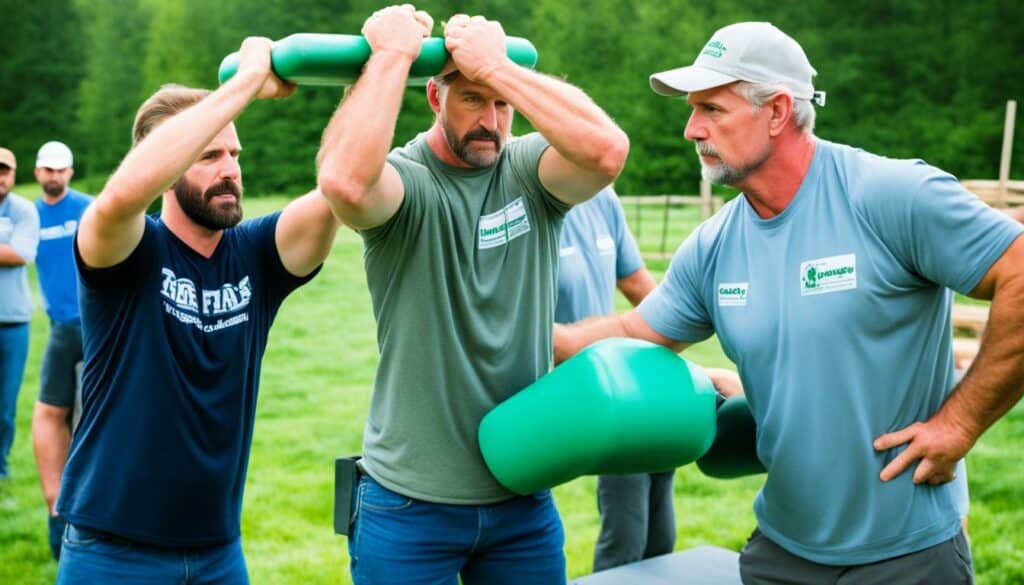
Its goals include teaching farmers about muscle injuries and how to prevent them. The team and I see how vital it is to train in ergonomics and use tools that make farming safer. These steps help lower the risk of harm while working.
The program’s big aims are:
This all-round approach has been boosted by a recent $22,000 grant for farmworker safety in North Carolina. It puts a strong focus on training and tools that match farmers’ needs. This effort helps keep workers safe and effective in farming.
Partnerships with groups like the NC A&T Cooperative Extension and Easter Seals UCP North Carolina have made this work known far and wide. By working together, we can show everyone the value of working safely on the farm.
Plus, over 170 Assistive Technology therapists and their clients have been taught by this program. This has opened up more help and info for disabled farmers. This hands-on support is crucial for these farmers’ success.
The NC AgrAbility Program truly shines in its smart, hands-on approach for a safer farm workplace. It shows how to be active and flexible in looking after the health and safety of farm workers.
Investing in ergonomic training in the agricultural sector is a smart move for employers. It boosts farm laborer wellbeing by reducing injuries. This, in turn, makes the workforce more productive. These programs also lower costs for the company and minify employees leaving their jobs.
A report by the International Labour Organisation (ILO) has praised safety training for farmworkers. It helps them learn and follow safety steps better. This means workers are off sick less and get hurt less. So, it helps them work better.
Ergonomic training is also good for farming health programs. It makes workers happier. This is key for creating a team that feels supported and works hard. Laws like Italy’s Decreto Legislativo 9 aprile 2008 n. 81 push for strong health and safety rules, making these programs important.
Tests to see how easy training is to use make a big difference. Making sure farm workers understand and find training practical helps. It means safety rules are easy to follow.
Looking at the best ways to work, like with RULA and REBA, helps find where safety training is needed most. This points out the areas to focus on. Then, specific plans can be made to keep farm laborer wellbeing high.
In short, training farm workers in ergonomics helps employers have a successful, happy team. It makes working safer and more satisfying. And it boosts how much work gets done and how profitable the company is in the tough farming market.
| Benefits | Details |
|---|---|
| Increased Productivity | Lower absenteeism and reduced injury rates contribute to higher efficiency and output. |
| Lower Compensation Costs | Fewer injuries mean reduced medical and compensation expenses. |
| Enhanced Employee Morale | Workers feel valued and protected, leading to better job satisfaction and commitment. |
| Reduced Turnover Rates | A healthier and happier workforce is more likely to stay with the employer, reducing recruitment and training costs. |
The agricultural sector faces many ergonomic hazards affecting worker health and productivity. Effective farm safety training aims to spot and lessen these dangers. This leads to a healthier workplace for field workers. Recognising and addressing these risks is key. It helps us create field worker safety programs that tackle the main concerns.
Farm workers often perform repetitive tasks, which can cause severe musculoskeletal disorders. This includes activities like heavy lifting, bending, and using vibrating tools. Such tasks can lead to chronic stress on the body. As a result, backaches, shoulder pains, and arm discomfort are common. Using ergonomic practices reduces this stress, cutting the odds of injuries.

Heavy lifting is a significant risk in farming, leading to many work-related injuries. About a third of these injuries result in absences, with a quarter affecting the back directly. For instance, in California, treating over 3,000 back injuries costs more than $22 million a year. It’s key to teach proper lifting methods and use tools that help to lower body stress. Ergonomic changes like adjusting load heights and using handles on containers can lessen injury risks.
Dealing with these hazards through farm safety training and field worker safety programs makes farm work safer and more effective. This benefits both the workers and the employers.
Even small farms can make work safer. They face challenges like injuries from lifting and back problems.
One-third of the injuries that make farm workers miss work are sprains and strains. A quarter are back injuries. Small farms can use an agricultural ergonomics course to teach their staff how to work safely.
*Work-related musculoskeletal disorders* (WMSDs) are a big problem for those of working age. Learning and using ergonomic tools can help. This can lower the chance of farm workers getting back pain or shoulder, arm, and hand pain.
Tailored solutions mean farms can focus on safer tools and how work is done. Making tools better can help avoid injuries. This happens by making work positions better and reducing the physical effort or doing the same tasks over and over.
Here’s a quick look at how ergonomic solutions help small farms be safer:
| Injury Type | % of Incidents | Impact of Ergonomic Solutions |
|---|---|---|
| Sprains and Strains | 33% | Significant reduction with proper training |
| Back Injuries | 25% | Lowered risk through improved posture and tools |
| Musculoskeletal Disorders (WMSDs) | Leading Cause | Prevented by reduced repetition and force |
In California agriculture, over 3,000 back injuries might cost more than $22 million each year.
By using ergonomic solutions and joining an agricultural ergonomics course, small farms can save money. They’ll also make the workplace safer and better for their workers.
Using the right tools and training means farms are safer places to work. This not only helps workers but also makes the farm more productive and sustainable. Special *small farm safety solutions* are good investments for the future of the farm and its people.
It’s vital to train farm supervisors and safety managers in ergonomic principles. This helps make safety practices better on farms. The farm industry’s high rate of fatal injuries shows why farm safety training is so important.
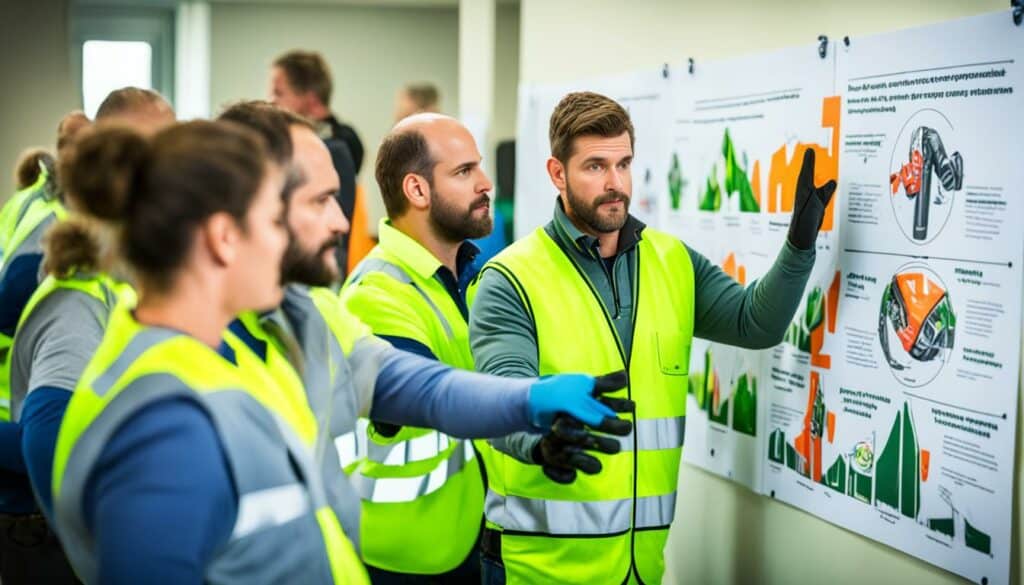
Many farm deaths are from transportation. This includes tractor accidents and crashes on roads. So, supervisors learn about these risks and how to make them smaller with agrarian worker ergonomics.
Supervisors and managers are the link between what should be done and what happens on farms. For example, they learn about how common MSDs are in the forest sector. Knowing this helps them teach about the need for ergonomic action.
OSHA has rules for farm safety, such as in 29 CFR 1928 and 29 CFR 1910. These rules guide the training. Also, trained staff do regular checks to find and lower farm risks. This means better safety plans and ways to leave the farm safely in an emergency.
Training staff with this knowledge makes farm safety methods better over time. For instance, the webinar “Musculoskeletal and Ergonomic Safety for Forest Workers” is a good resource. After watching, a test with at least 4 correct answers is needed to get certified. This makes ongoing learning appealing to managers, with a 1.00 Online Education Hours certification as a reward.
By making farm supervisors learn about ergonomics and strictly follow safety rules, agriculture can become safer. This approach tackles the dangers of big machines and toxic chemicals on farms.
Implementing the best practices in agricultural ergonomics is key to reducing work-related musculoskeletal disorders (WMSDs). It is important to identify the unique risks farm work presents. These include forceful gripping, kneeling, and lifting, among others. Ergonomic solutions must match the farm’s specific needs to succeed.
Worker involvement is crucial for developing effective ergonomic programs. It ensures that solutions are both practical and empowering. Workers learn about proper body mechanics and use of assistive tools. They also discover ways to reduce physical stress.
By following these steps, farm workers can lower the risk of WMSDs. This is vital as WMSDs are the top reason for disability in working age people. Ergonomic guidelines for using hand tools and lifting are also important. They help to lessen body strain.
In California, WMSDs lead to over 3,000 back injuries yearly in agriculture. The cost in worker compensation exceeds $22 million. By offering solid ergonomic training, many of these injuries can be prevented. It shows the importance of updating training materials regularly to meet new standards.
The aim of ergonomic training is to make jobs safer and more comfortable for farm workers. With the right practices in place, the farming sector can lower injury rates. This helps create a workforce that is healthier and more durable.
Interactive training is key for farm workers to learn and remember ergonomic rules easily. They often face health risks, like injuries to the muscles and bones. In 2011, a study found that training on safety issues made a big difference in how well people learned.
Showing workers how to lift and handle things safely is very helpful. In 2016, an early study showed that practical lessons made a big difference. These lessons make it easier for workers to connect theory with actual work.

Talking in groups can also help a lot. It lets workers compare notes and problem-solve together. A 2018 review showed that this is a powerful way to train people on safety.
Challenge-solving workshops are made for finding and solving ergonomic problems as they happen. In 2014, a study showed that letting workers help create solutions makes training better. This kind of training gets everyone involved, improving workplace health.
Seeing videos and charts can also make complex ideas clear. A 2002 study on pesticide education videos is a good example. It showed that workers learn better when they have visual tools. This is good for everyone, no matter their learning style.
Using these hands-on and interactive methods doesn’t just fix immediate risks. It helps build a culture of always getting better and being aware of safety. Incorporating these tactics into training is crucial for protecting the health of farm workers.
The economic effect of ergonomic injuries in farming is huge. It covers direct and indirect costs. The direct health care costs alone are over $167,250,000. These costs don’t include the impact on productivity or other financial losses.
MSDs are the most common non-fatal job illnesses in farming. This is especially true for female workers according to the National Health Interview Survey. These injuries greatly affect the health of farm workers.
In places like California, farm work has high rates of MSDs. For example, jobs in nursery and floriculture have 40 cases per 1000 workers. Vineyard work has 80 cases per 1000. This shows the urgent need for better ergonomics and injury prevention.
Workplace injuries have high direct and indirect costs, including employee turnover. To keep farms profitable and sustainable, helping workers through ergonomic support and training is vital.
| Industry | Injury Rate (per 10,000 workers) | Direct Costs (millions $) |
|---|---|---|
| Agriculture | 60/1000 | 167.25 |
| Meat Packing | 922/10,000 | Not Reported |
| Knit Underwear Mills | 910/10,000 | Not Reported |
| Motor Vehicles and Car Bodies | 711/10,000 | Not Reported |
In the agricultural sector, specific resources and funding exist for making ergonomic training programs. These make it easier to create strong training materials. They also help get needed equipment by offering financial help.
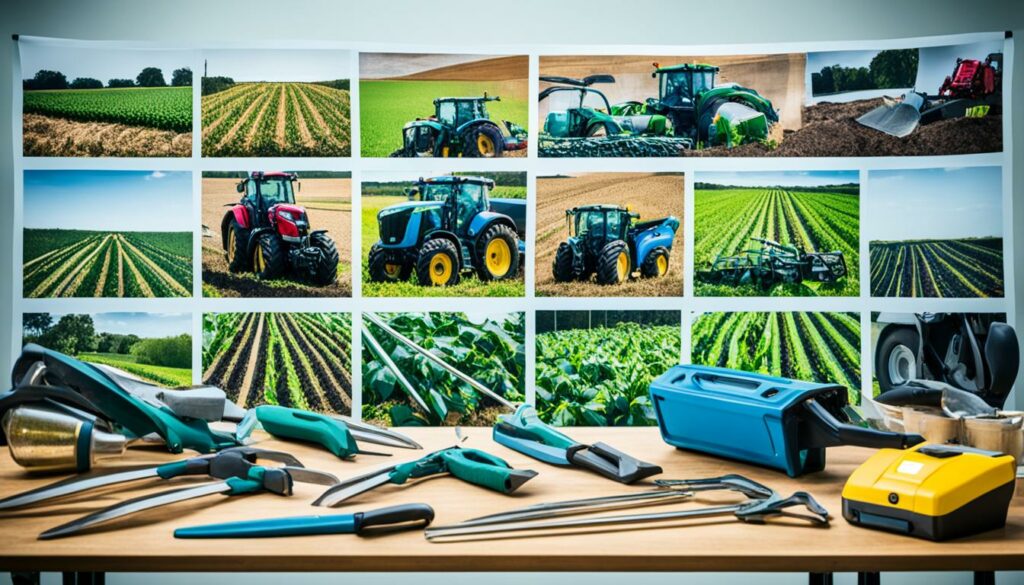
Tools for educating on ergonomic principles are key for farm workers. These tools include:
It’s crucial to find funding for farm safety training to run ergonomic programs well. Different ways to get support are available:
Using these resources and funding options can greatly increase safety, ease, and efficiency for farm workers.
In agriculture, government h elps make working on farms safe. They set Occupational Safety and Health rules and offer advice on how to work better. This lowers the chances of farm workers getting hurt, which can cost a lot of money to treat. For example, in California farm work, treating over 3,000 back injuries a year can cost more than $22 million. This makes it clear why the help from the government is so important.
Many farm work injuries that keep workers from working are due to sprains, strains, and back problems. These injuries lead to big problems for workers and the farms they work for. The government helps by teaching better ways to work and using tools that make jobs safer.
| Injury Type | Percentage of Total Injuries | Annual Workers’ Compensation Cost |
|---|---|---|
| Sprains and Strains | 33% | $22 million |
| Back Injuries | 25% |
Also, companies play a big role in making farm jobs safer. They share the best ways to work and might change tools to help. Working together, they can stop a lot of injuries. For example, teaching the right way to lift, making tools easier to hold, and avoiding working bent over too much can help a lot.
Companies give out guides, run teaching sessions, and are always there for ongoing help. This makes sure farm workers know how to stay safe and healthy. By looking out for each other, the government and companies make farming safer for everyone.
Ergonomic training is vital for farmworkers to tackle health and safety in agriculture. By teaching about ergonomics and using assistive tech, we improve workers’ lives. Studies have proven that focusing on safety reduces risks and makes work safer. For instance, the Pesticides and Farmworker Health Toolkit has helped farmworkers understand safety more (Journal of Agromedicine 2014;19:96–102).
Musculoskeletal disorders (MSDs) are a big worry for farmworkers, being the most common non-fatal risk at work. We need tailored ergonomic solutions for tasks like manual feeding of woodchippers. For back pain, a common disorder, we must educate on proper posture. This education is key for addressing MSDs.
The heat also poses risks for farmworkers, especially Latino workers. Ergonomic training is crucial here too. Simple changes, like using smaller tubs for grape picking, can greatly reduce pain. These efforts show how even small adjustments can make a big difference. They also stress the need for everyone to work together for lasting change.
Ergonomic training helps farm workers learn about their body movements and posture. It shows them how to use tools that make their work easier and safer. This training is designed specifically for agriculture to boost safety and health.
Ergonomic training is key for farm workers to avoid getting hurt. It covers how to avoid injuries from repeating the same movements, lifting heavy things, or working in odd positions. By learning good habits, workers are safer, happier, and more productive.
Farm workers often suffer from pains and injuries in their back, shoulders, arms, and hands. These issues come from doing the same actions over and over, lifting heavy stuff, and working in strange ways.
A good ergonomic training should teach about the right way to move and stand. It also shows how to use special tools and how to lift things properly. The goal is to stop these muscle and bone problems and keep workers safe.
By making tools and the way work is done better, the chance of getting hurt is lower. These changes can be small or big, depending on what each farm needs. They are made to fit the way farming is done, stopping injuries before they happen.
Assistive technology gives farm workers tools and devices that are easy on their bodies. Things like special tools, machines that help lift, and workstations adjusted for each person lower the risk of getting hurt. This technology is important for keeping up with safety standards and making work more effective.
The NC AgrAbility Program aims to teach farm workers about muscle and bone injuries. It gives out tips for working with crops that are easier on the body. The program also suggests tools and ways of working that prevent injuries.
Ergonomic training helps employers by improving the health and safety of their workers. It makes workers more productive and less likely to hurt themselves. This training saves money on health care and keeps workers happy and loyal.
Farming has risks like doing the same movements too much and lifting heavy things. Without ergonomic solutions, these can lead to injuries and sickness. Training helps to avoid these dangers.
Small farms can use simple, smart tools and teach their workers how to use them correctly. By tailoring these tools and training to their specific needs, they reduce worker discomfort and the risk of getting hurt.
Supervisors and managers can share what they learn with their teams. This makes sure that everyone knows how to work safely. Their training keeps up good ergonomic practices on the farm.
A good program starts by spotting what might hurt workers. It then figures out what things to change or add to make work safer. Workers help plan how to teach these safety steps. The guides, tools, and checks for learning are regularly updated.
Hands-on demos, talking in groups, and solving problems together help workers learn better. These ways of teaching are fun and make safety rules easier to remember. They help everyone see why ergonomics matter and how to use it every day.
Getting hurt costs farms a lot of money, from doctor’s bills to less work getting done. But by investing in stopping these injuries, farms save money in the end and make sure their workers stay healthy and keep their jobs.
There are videos, sheets of advice for different tasks, and help buying things that make work safer. Also, there’s support money to push for a safer working environment. These resources aim to make farming safer all around.
They make rules to protect workers and share the best ways to work safely. By giving advice and checking how safe farms are, they help everyone in the industry be healthier and happier at work.